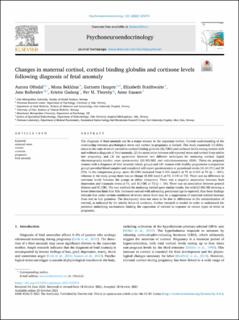| dc.contributor.author | Bekkhus, Mona | |
| dc.contributor.author | Haugen, Guttorm Nils | |
| dc.contributor.author | Braithwaite, Elizabeth | |
| dc.contributor.author | Bollerslev, Jens | |
| dc.contributor.author | Godang, Kristin | |
| dc.contributor.author | Thorsby, Per Medbøe | |
| dc.contributor.author | Kaasen, Anne | |
| dc.date.accessioned | 2021-12-08T13:13:47Z | |
| dc.date.available | 2021-12-08T13:13:47Z | |
| dc.date.created | 2021-11-10T10:43:45Z | |
| dc.date.issued | 2021-10-23 | |
| dc.identifier.issn | 0306-4530 | |
| dc.identifier.uri | https://hdl.handle.net/11250/2833367 | |
| dc.description.abstract | The diagnosis of fetal anomaly can be a major stressor to the expectant mother. Current understanding of the relationship between psychological stress and cortisol in pregnancy is limited. This study examined: (1) differences in the ratio of serum cortisol to cortisol binding globulin (SC/CBG) and cortisone levels among women with and without a diagnosis of fetal anomaly, (2) the association between self-reported stress and cortisol from mid to late pregnancy, and (3) the agreement between two different techniques for analyzing cortisol: liquid chromatography-tandem mass spectrometry (LC-MS/MS) and radioimmunoassay (RIA). Thirty-six pregnant women with a diagnosis of fetal anomaly (study group) and 101 women with healthy pregnancies (comparison group) provided blood samples and completed self-report questionnaires at gestational weeks 18–24 (T1) and 30 (T2). In the comparison group, mean SC/CBG increased from 0.341 nmol/L at T1 to 0.415 at T2 (p < .001), whereas in the study group there was no change (0.342 nmol/L at T1, 0.343 at T2). There was no difference in cortisone levels between the groups at either timepoints. There was a negative association between both depression and traumatic stress at T1, and SC/CBG at T2 (p < .05). There was no association between general distress and SC/CBG. The two methods for analyzing cortisol gave similar results, but with LC-MS/MS showing a lower detection limit than RIA. Increased cortisol with advancing gestational age is expected, thus these findings indicate that under certain conditions of severe stress there may be a suppression of maternal cortisol increase from mid to late gestation. The discrepancy does not seem to be due to differences in the metabolization of cortisol, as indicated by the similar levels of cortisone. Further research is needed in order to understand the potential underlying mechanisms limiting the expression of cortisol in response to certain types of stress in pregnancy. | en_US |
| dc.description.sponsorship | This work was supported by the Research Council of Norway (RCN; grant number 288083 and 301004), Norwegian Women’s Public Health Association, the Norwegian Association for Children with Congenital Heart Disease, University of Oslo and Oslo University Hospital. | en_US |
| dc.language.iso | eng | en_US |
| dc.publisher | Elsevier | en_US |
| dc.relation.ispartofseries | Psychoneuroendocrinology;Volume 135, January 2022, 105574 | |
| dc.rights | Navngivelse 4.0 Internasjonal | * |
| dc.rights.uri | http://creativecommons.org/licenses/by/4.0/deed.no | * |
| dc.subject | Maternal stress | en_US |
| dc.subject | Cortisol | en_US |
| dc.subject | Cortisone | en_US |
| dc.subject | Pregnancies | en_US |
| dc.subject | Fetal anomalies | en_US |
| dc.title | Changes in maternal cortisol, cortisol binding globulin and cortisone levels following diagnosis of fetal anomaly | en_US |
| dc.type | Peer reviewed | en_US |
| dc.type | Journal article | en_US |
| dc.description.version | publishedVersion | en_US |
| dc.rights.holder | © 2021 The Author(s). | en_US |
| dc.source.articlenumber | 105574 | en_US |
| cristin.ispublished | true | |
| cristin.fulltext | original | |
| cristin.qualitycode | 2 | |
| dc.identifier.doi | https://doi.org/10.1016/j.psyneuen.2021.105574 | |
| dc.identifier.cristin | 1953091 | |
| dc.source.journal | Psychoneuroendocrinology | en_US |
| dc.source.volume | 135 | en_US |
| dc.source.pagenumber | 1-8 | en_US |
| dc.relation.project | Norges forskningsråd: 288083 | en_US |
| dc.relation.project | Norges forskningsråd: 301004 | en_US |

